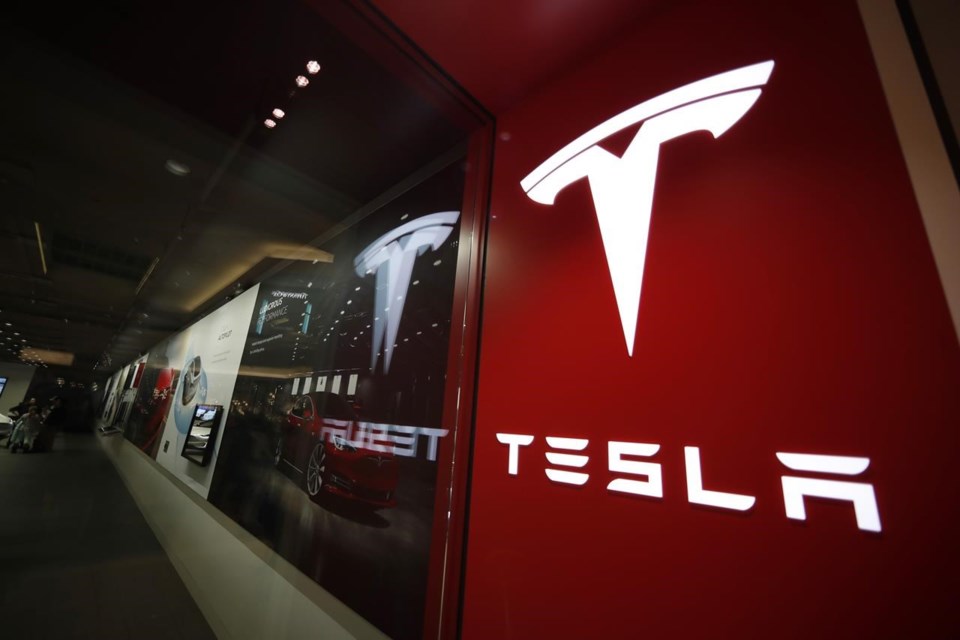MEXICO CITY (AP) ŌĆö Mexico is undergoing a fevered competition among states to win a potential Tesla facility in jostling reminiscent of what happens among U.S. cities and states vying to win investments from tech companies.
Mexican governors have gone to loopy extremes, like putting up billboards, creating special car lanes or creating mock-ups of Tesla ads for their states.
And thereŌĆÖs no guarantee Tesla will build a full-fledged factory. Nothing is announced, and the frenzy is based mainly on Mexican officials saying Tesla boss Elon Musk will have an upcoming phone call with Mexican President Andr├®s Manuel L├│pez Obrador.
The northern industrial state of Nuevo Leon seemed to have an early edge in the race.
It painted the Tesla logo on a lane at the Colombia border crossing into Texas last summer, and erecting billboards in December in the state capital, Monterrey, that read ŌĆ£Welcome Tesla.ŌĆØ
The state governorŌĆÖs influencer wife, Mariana Rodriguez, was even shown in leaked photos at a get-together with Musk.
However, L├│pez Obrador appeared to exclude the semi-desert state from consideration Monday, arguing he wouldnŌĆÖt allow the typically high water use of factories to risk prompting shortages there.
That set off a competitive scramble among other Mexican states, like feeding time at a piranha tank. The governorsŌĆÖ offers ranged from crafty proposals to near-comic ones.
ŌĆ£Veracruz is the only state with an excess of gas,ŌĆØ quipped Gov. Cuitl├Īhuac Garc├Ła of the Gulf coast state of Veracruz, before quickly adding ŌĆ£gas ŌĆ” for industrial use, for industrial use!ŌĆØ
A late-comer to the race, Garc├Ła had to try harder: He noted Veracruz was home to MexicoŌĆÖs only nuclear power plant. And he claimed Veracruz had 30% of MexicoŌĆÖs water, though the National Water Commission puts the stateŌĆÖs share at around 11%. Water, it turns out, is thicker than blood.
The governor of the western state of Michoacan wasnŌĆÖt going to be left out. Gov. Alfredo Ram├Łrez Bedolla quickly posted a mocked-up ad for a Tesla car standing next to a huge, car-sized avocado ŌĆö MichoacanŌĆÖs most recognizable product ŌĆö with the slogan ŌĆ£Michoacan ŌĆö The Best Choice for Tesla.ŌĆØ
ŌĆ£We have enough water,ŌĆØ Ram├Łrez Bedolla said in a television interview he did between a round of meetings with auto industry figures and international business representatives.
Michoacan also has an intractable problem of drug cartel violence. But similar violence in neighboring Guanajuato state hasnŌĆÖt stopped seven major international automakers from setting up plants in Guanajuato.
Nuevo Leon Gov. Samuel Garc├Ła had to think fast to avoid being shut out entirely, and came up with a novel strategy.
Garc├Ła reached out to the western state of Jalisco, whose governor, Enrique Alfaro, belongs to the same small CitizenŌĆÖs Movement party. Together, the two came up with an ŌĆ£allianceŌĆØ Thursday that would allow trucks from Jalisco preferential use of Nuevo LeonŌĆÖs border crossing, the same one where a ŌĆ£TeslaŌĆØ lane appeared last year.
Jalisco has an already healthy foreign tech sector, but most importantly, it has more water than Nuevo Leon.
The two appeared intent on playing nice. ŌĆ£We are two states that do not have to compete and cannibalize each other ŌĆ” cannibalization for investment is a mistake,ŌĆØ Alfaro said.
L├│pez ObradorŌĆÖs focus on water might be more about politics than about droughts, said Gabriela Siller, chief economist at Nuevo Leon-based Banco Base. She said the president appeared to be trying to steer Tesla investment to a state governed by his own Morena party, like Michoacan or Veracruz.
That could be a dangerous game, Siller said.
ŌĆ£Tesla could say itŌĆÖs not somebodyŌĆÖs toy to be moved around anywhere, and it could decide not to come to Mexico,ŌĆØ she said.
Sam Abuelsamid, a principal research analyst at U.S.-based Guidehouse Insights, said playing one state off against another has been common practice in the U.S.
ŌĆ£You remember a few years back, Amazon talked about building their headquarters, like every state, city in the country was putting in bids, trying to lure Amazon there,ŌĆØ Abuelsamid said.
There are doubts that whatever Musk eventually does announce will be an auto assembly plant. Foreign Relations Secretary Marcelo Ebrard said his understanding is that it wonŌĆÖt be a plant, but rather an ŌĆ£ecosystemŌĆØ of suppliers.
Musk previously has made promises that donŌĆÖt come true, or happen years after he says they will. For instance, in 2019 he promised a fleet of fully autonomous robotaxis on the roads sometime in 2020. Nearly three years later, Tesla has yet to sell any autonomous vehicles.
While there has been little talk in Mexico so far of subsidies, many auto companies have gotten significant incentives to build plants in Mexico. That kind of race can be costly.
ŌĆ£ItŌĆÖs questionable whether itŌĆÖs actually that economically beneficial to localities or providing those subsidies,ŌĆØ said Abuelsamid. ŌĆ£TheyŌĆÖre sometimes spending billions of dollars in tax breaks to lure a company in there.ŌĆØ
Musk at times has floated the idea of building a $25,000 electric vehicle that would cost about $20,000 less than the current Model 3, now TeslaŌĆÖs least-expensive car. Many automakers build lower-cost models in Mexico to save on labor costs and protect profit margins.
A Tesla investment could be part of ŌĆ£near shoringŌĆØ by U.S. companies that once manufactured in China but now are leery of logistical and political problems there. That those companies will now turn to Mexico represents the Latin American countryŌĆÖs biggest foreign investment hope.
ŌĆ£The fight among states to attract investments from this nearshoring phenomenon is going to be tough, complicated,ŌĆØ Alfaro said.
As Ram├Łrez Bedolla put it, ŌĆ£wherever Tesla sets up, it is going to be big news in Mexico.ŌĆØ
Mark Stevenson, The Associated Press



